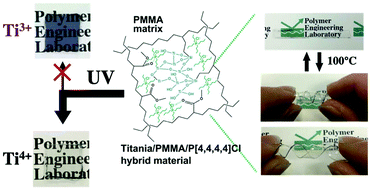Improvement of the transparency, mechanical, and shape memory properties of polymethylmethacrylate/titania hybrid films using tetrabutylphosphonium chloride†
Abstract
The sol–gel method remains an attractive approach for dispersing an inorganic component in a polymer matrix on the mesoscopic scale. However, the interaction of inorganic components with polymer side chains increases uncontrolled crosslinking points and brings about the fatal loss of toughness in polymer materials. In this study, we report the use of tetrabutylphosphonium chloride (TBPC) as an ionic liquid to intercept interaction between polymethylmethacrylate (PMMA) and titania. The addition of TBPC to the PMMA/titania hybrid system is shown to improve transparency, toughness, and shape memory properties (SMPs). A tensile test showed that the hybrid system containing 40 wt% TBPC had a breaking energy (362.1 kJ m−3) that was ∼28 times greater than that of the film without ionic liquid (14.1 kJ m−3). In addition, the SMPs of the system were; strain (44%), shape fixation ratio (99%), and shape recovery (88%) as a result of the controlled crosslinking points. Interestingly, we coincidentally found that TBPC suppresses the photochromic activity of titania despite UV irradiation (250 W, 2 h), which helps to improve the degradation of titania hybrid film transparency. The use of TBPC in hybrid films is effective for designing materials with multifunctionality, including optical, mechanical, and shape memory properties.



 Please wait while we load your content...
Please wait while we load your content...